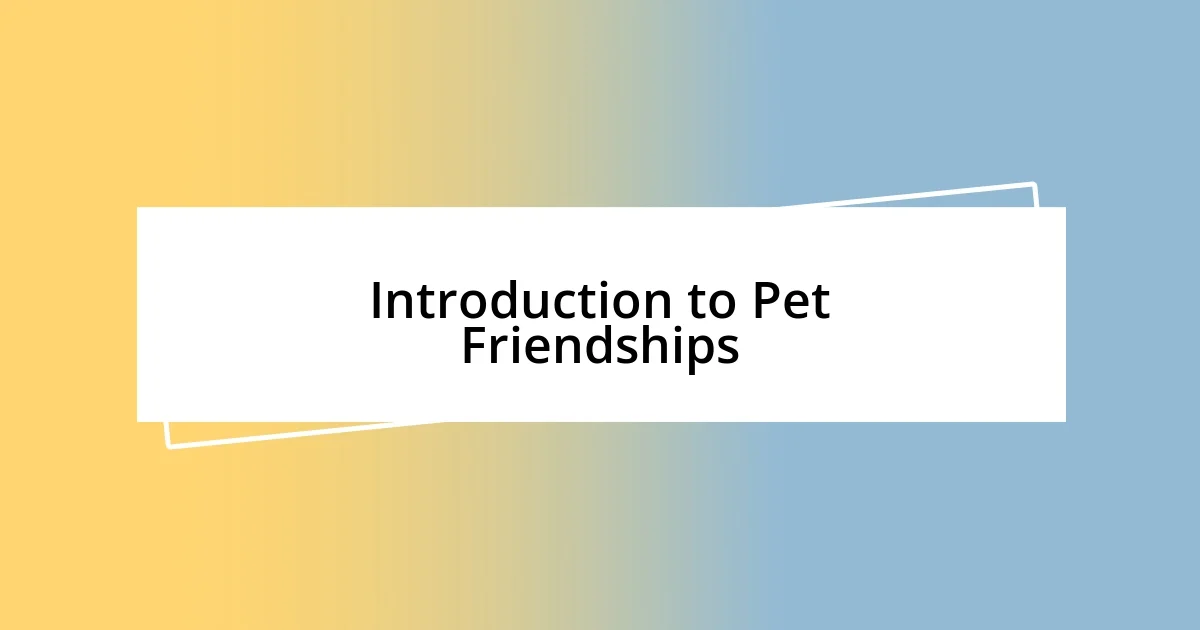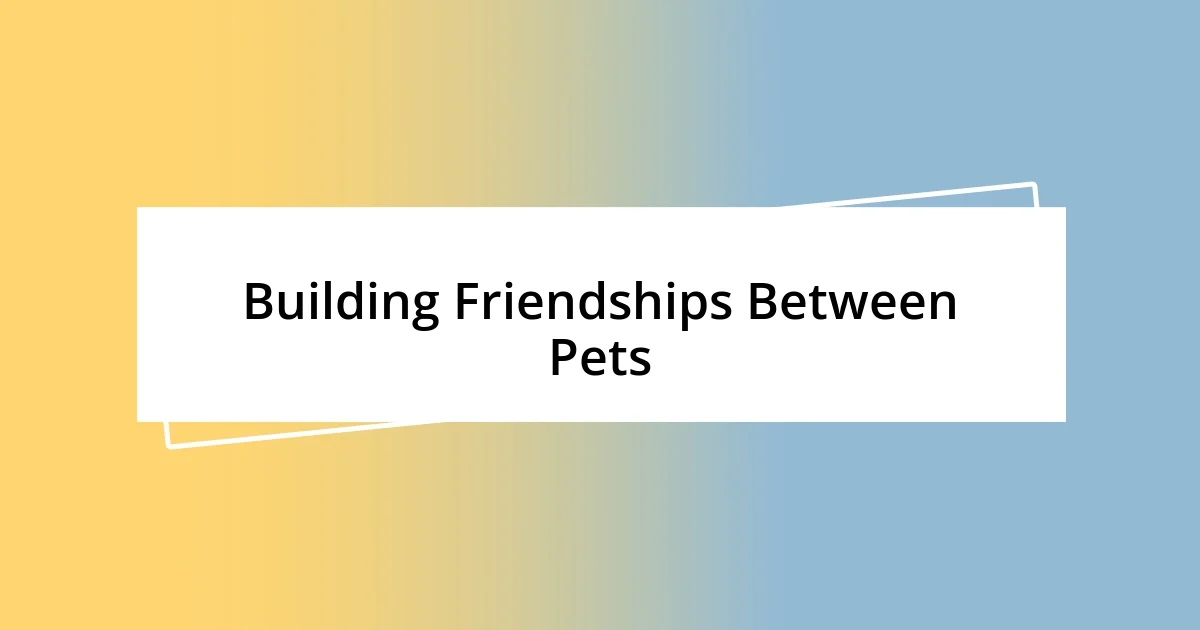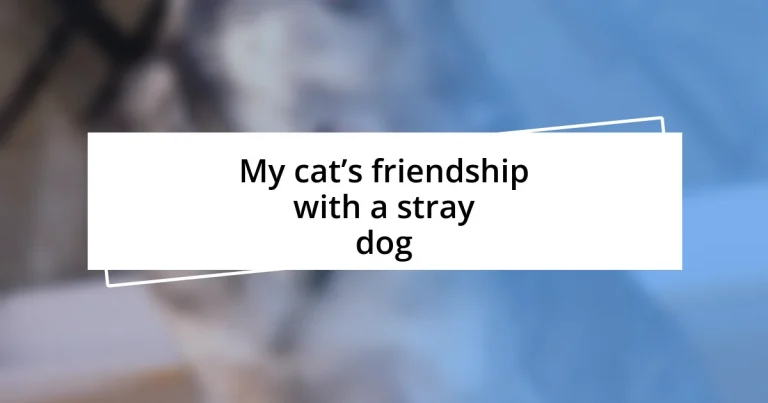Key takeaways:
- Pet friendships can form unexpectedly across species, showcasing acceptance and love beyond boundaries.
- Understanding animal behavior, such as cat body language and stray dog adaptability, is crucial for fostering positive interactions.
- Creating a harmonious environment through careful introductions, positive reinforcement, and attention to emotional needs strengthens bonds between pets.

Introduction to Pet Friendships
Pet friendships can be as diverse and heartwarming as the animals themselves. I remember one sunny afternoon watching my cat, Luna, cautiously approach a stray dog in the park. Their eventual playfulness reminded me how friendships can blossom in the most unexpected situations, regardless of species.
Have you ever wondered what goes through an animal’s mind when they connect with a friend who is so different from them? Observing these interactions often brings a sense of joy and curiosity. It’s fascinating to see how these bonds are formed, typically through play, shared spaces, or mutual curiosity. They bypass our human biases and teach us valuable lessons about acceptance.
There’s something truly magical about seeing harmony between two disparate personalities. I recall the day Luna and the stray dog curled up together for a nap, creating a cozy scene that made my heart swell. Their friendship transcended typical boundaries, proving that companionship can thrive in any form, reminding us all that love knows no bounds.

Understanding Cat Behavior
Understanding cat behavior can be a delightful puzzle. Cats are incredibly nuanced creatures, often expressing a range of emotions through body language and vocalizations. When Luna first met the stray dog, her ears were slightly back, and her tail flicked—signs of both curiosity and caution. This initial hesitation is a typical cat reaction; they often assess situations before fully engaging.
Here are some key behaviors to look for in cats:
- Purring: Indicates contentment but can also signal discomfort in certain contexts.
- Kneading: A comforting behavior often seen in cats, recalling their kittenhood.
- Slow Blinking: A sign of trust; if a cat gazes and then slowly closes its eyes, they’re showing affection.
- Tail Position: A high tail means a happy, confident cat; a low tail signals fear or insecurity.
Understanding these signals can enhance our interactions and help us create better environments for our feline companions. Adopting this perspective was essential for me when observing Luna; recognizing her moods transformed my relationship with her, allowing me to respect her boundaries while nurturing our bond. It’s quite moving to witness how cats articulate their feelings, isn’t it?

Stray Dog Characteristics
Stray dogs possess a unique blend of traits shaped by their experiences. One distinct characteristic is their adaptability. Unlike pets that live under comfortable, protective circumstances, stray dogs must navigate various environments, often becoming quite resourceful. I’ve seen this firsthand; when my cat Luna first encountered the stray dog, the dog exhibited an impressive ability to scan the surroundings and react accordingly.
Another notable trait is their social behavior. Stray dogs often develop a keen sense of trust, particularly towards those who show them kindness. I recall the moment when Luna and the stray dog met: the dog approached cautiously but enthusiastically when offered a few treats, showcasing its ability to form connections despite its uncertain past. It highlighted an essential truth: even animals without stable homes can recognize friendship and comfort.
In terms of health, stray dogs often display signs of resilience; they can endure hardships and adapt to challenging situations. However, they might also face health issues due to lack of shelter or regular veterinary care. I’ve noticed how these dogs can embody a spirit of survival, which sometimes translates into energetic playfulness with other animals, including my own cat. It’s touching to witness the joy they find in simply being around others.
| Characteristic | Description |
|---|---|
| Adaptability | Stray dogs have learned to thrive in various environments, showcasing resourcefulness. |
| Social Behavior | They tend to develop trust with kind individuals, forming bonds despite past hardships. |
| Resilience | Stray dogs often exemplify a strong survival spirit, embodying joy amid adversity. |

Building Friendships Between Pets
Building friendships between pets can be a beautiful journey, filled with unexpected moments. I remember the day Luna cautiously approached the stray dog. At first, it was a dance of uncertainty, a slow exploration of each other’s presence. When they finally touched noses, it felt like a small yet profound moment of connection. Isn’t it fascinating how two different animals can break down barriers simply through curiosity and patience?
Creating a bond between pets often requires a gentle approach. I found that allowing them to interact at their own pace was crucial. For instance, I offered both of them treats during their first encounters, encouraging positive associations with one another. This tactic not only helped ease their initial tension but also sparked a playful energy between them. How often do we underestimate the power of sharing something positive to foster friendship?
As I observed Luna and the stray dog build their friendship, I noticed a wonderful transformation in their behavior. The initial cautiousness evolved into playful antics, with Luna swatting at the dog’s tail and the dog playfully leaping away. This evolution reminded me of the importance of trust and communication among pets. When they feel safe, even the most unlikely friendships can blossom, providing joy and companionship for both animals involved. Isn’t it heartwarming to witness such genuine connections?

Tips for Introducing Pets
Introducing new pets to each other can be a thrilling yet delicate process. When I first brought the stray dog home, my heart raced as I watched Luna observe from a distance. I remember how essential it felt to create a safe space for both. Providing separate areas for each pet initially allowed them to acclimate without overwhelming one another. Have you ever noticed how a little distance can ease anxiety? It truly works wonders.
One clever method I employed was to let them swap scents before any face-to-face meetings. I rubbed a towel on the stray dog and then let Luna sniff it, and vice versa. It helped them get familiar with each other’s scent, which I found crucial for reducing tension. It’s like giving them a sneak peek into each other’s world without any pressure. I still smile thinking about Luna’s curious twitch when she first sniffed that towel—it was the beginning of their friendship!
Once they seemed more comfortable, I always supervised their first encounters. I recall sitting on the floor with treats in hand, ready to reward them for calm behavior. Their gradual curiosity turned into playful nudges. I can’t express how much joy filled the room as I witnessed their bond strengthen. Isn’t it incredible how patience and positive reinforcement can pave the way for lasting friendships?

Observing Their Interactions
As I spent more time observing their interactions, I noticed delightful little nuances that brought a smile to my face. One sunny afternoon, while lounging on the porch, I saw Luna rolling on her back, inviting the dog to join her in play. The dog hesitated but then approached cautiously, mirroring her playful spirit. This moment of mutual exhibition truly illustrated their growing friendship. Have you ever witnessed such pure joy in animals? It’s like they speak a language we can only feel.
There was another instance that filled my heart with warmth. During a brief rain shower, I watched as the dog playfully splashed in a puddle while Luna perched on a nearby fence, observing intently. She seemed almost curious and amused, her tail twitching with excitement. After a few moments, she leaped down and joined him, and suddenly the two were chasing raindrops together. It was genuine bliss, and I couldn’t help but reflect on how their friendship was redefining the way they viewed the world around them.
I have to admit, there were moments that tugged at my heartstrings too. One evening, I caught the stray dog gently nudging Luna when she was curled up alone. It was as if he sensed her need for company, prompting her to join him for a cozy cuddle on my lap. This beautiful display of empathy reminded me of how friendship goes beyond mere play; it’s about understanding and comfort. Isn’t it fascinating how animals can teach us about connection in ways we often overlook?

Maintaining Peaceful Coexistence
Maintaining a harmonious environment for both Luna and the stray dog became a priority for me. One evening, I realized the power of scheduling their playtime to avoid conflicts. I set aside specific hours when they could interact and times they could each have alone moments. It was as if I’d orchestrated their little world. It may sound a bit over the top, but keeping their routines balanced truly reduced any territorial disputes. Have you ever noticed how a little structure can bring peace to a chaotic situation?
Another practice I adopted was positive reinforcement, which I found incredibly effective. Each time they played nicely together, I rewarded them with treats and praise. This not only encouraged good behavior but also built their trust. I can still recall the joy on their faces when they realized that being together resulted in yummy rewards. It makes you wonder: how often do we overlook the magic of encouragement in our own relationships?
Lastly, I learned the importance of being attentive to their emotional needs. One time, after a particularly rambunctious play session, I noticed Luna seemed a bit overwhelmed. I gently separated them and allowed her some quiet time. It was a simple yet profound reminder that we all need our space to recharge. Have you ever felt the need to step back and catch your breath? Listening to their cues helped ensure both pets felt valued and secure, which solidified their bond even further.














